By Loren J. Giesler, Former Extension Plant Pathologist
Pathogen
Bacterial pustule is caused by the bacterium Xanthomonas axonopodis pv. glycines. Like bacterial blight, bacterial pustule over winters in crop residue and is carried by wind or water droplets from the ground to the plant. In addition, the disease can be spread during cultivation while the foliage is wet. The bacterium will enter the plant through natural openings and wounds.
Video: Bacterial Diseases in Soybean
Disease Symptoms
In Nebraska, this disease is typically present on the upper leaves. Initial infection results in the development of tiny pale green spots on the new leaves. These spots have raised centers that may develop on either surface of the leaf but are more common on the lower leaf surface. As the disease progresses, small light colored pustules will form in the center of the spots. These spots may merge together to form irregular areas that appear as lesions. As spots mature the lesion and pustule turns brown.
This disease can easily be confused with soybean rust. Mature soybean rust pustules have a small opening at the top for spore release. Bacterial pustule lesions lack the opening on top and spores. If an opening is present, it is typically a linear crack across the surface of the pustule. These features can only be seen under magnification (20X or higher recommended). Bacterial pustule symptoms are also similar to those of bacterial blight but lesions do not appear water soaked and will have raised centers.
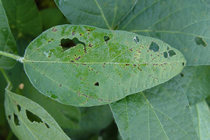
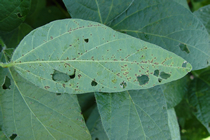
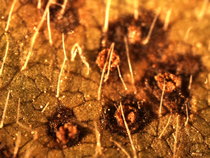
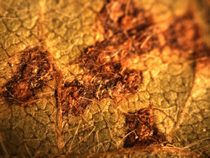
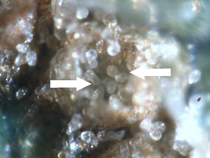

Favorable Environmental Conditions
Warm weather with frequent showers promotes the development of this disease. Unlike bacterial blight, warm temperatures do not limit development of bacterial pustule, as the optimal temperatures for disease development ranges from 86-92°F.
Management
The best management tool is to prevent disease establishment. Soybean varieties vary in their susceptibility to this disease and resistant varieties should be considered for planting fields with a history of the disease.
Cultural Pactices
Crop rotation can be an effective method to avoid inoculum from a previously infected crop. Incorporating crop residue by tillage will reduce the amount of inoculum available in the spring to infect plants; howeer, there are moisture and erosion issues to be considered. To prevent the spread of disease, limit cultivation to times when the foliage is dry.
Additional Resources
- Nebraska Extension NebGuide, Bacterial Disease of Soybean (G2058).
- North Central Soybean Research and Information Initiative: Bacterial Pustule
